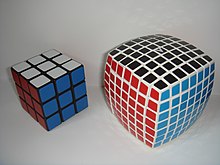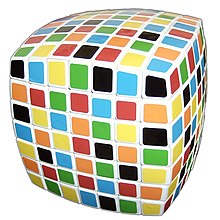V-Cube 7
The V-Cube 7 is the 7 × 7 × 7 version of Rubik's Cube ( Rubik's Cube). It was invented by Panagiotis Verdes and is also used by his company Verdes Innovations SA. manufactured. Like the 5 × 5 × 5 , the 7 × 7 × 7 has fixed and movable middle parts.
mechanism
The V-Cube 7 consists of 218 individual stones or cubies . The six central stones in the middle (out of a total of 150) are connected directly to the core of the puzzle with screws, which is why their position relative to one another does not change. The 144 other center stones can be moved freely. In contrast, the original 3 × 3 × 3 has only six central stones, the position of which does not change either. The 6 × 6 × 6 uses the same mechanism, but the middle row of each axis is sunk under the surface of the cube, so it is hidden by the other stones.
The 7 × 7 × 7 has 60 curb stones, each showing two colors; as well as eight corner stones, each showing three colors. However, not every color combination is available; for example, there is no stone that shows both red and orange, because red and orange are on opposite sides of the loosened cube.
Currently the V-Cube 7 is made with both white plastic and black plastic. In the standard color scheme, red is opposite orange, blue opposite green, and yellow opposite black and white, respectively (white plastic cubes have black stickers and black plastic cubes have white stickers). On the white or black middle part, the logo of the brand is mounted: a white (or black) V .
In contrast to the 6 × 6 × 6, the V-cube 7 has a curved surface. This is the only way to produce a cube with evenly wide edge stones. The Shengshou 7 × 7 × 7 and cubes from other manufacturers have planar surfaces, but the outermost layers are slightly thicker.
Positions
The cube has about 1.95 × 10 160 different positions (exactly 19 500 551 183 731 307 835 329 126 754 019 748 794 904 992 692 043 434 567 152 132 912 323 232 706 135 469 180 065 278 712 755 853 360 682 328 551 719 137 311 299 993 600 000 000 000 000 000 000 000 000 000 000 000 ). By printing a V s on the middle stone on one side, as is common with some dice, this number quadruples to 7.8 × 10 160 .
solution
For the 7 × 7 × 7 cube, the solution of the 5 × 5 × 5 cube can be used, since the sequence of moves for swapping individual parts is the same. Due to the higher number of individual parts, these train sequences only have to be carried out more frequently.
One of the best known strategies is the so-called reduction method, which is often used for all cubes larger than the 3 × 3 × 3. It consists in first arranging the middle and edge stones by color. After that, the cube can be solved equivalent to the 3 × 3 × 3 cube simply by using the outer axes of rotation.
The current world record for the fastest one-time solving of the 7 × 7 × 7 is 1: 40.89 minutes and was set by Max Park at CubingUSA Nationals 2019 .
Max Park holds the world record for the average time in solving the 7 × 7 × 7 three times with 1: 46.57 minutes, set at Houston Winter 2020 .
Solving the 7 × 7 × 7 blindly is not an official discipline, so there are no records for it.
swell
- V-cube patent At: freepatentsonline.com
Individual evidence
- ↑ List of 7 × 7 × 7 single world records on the World Cube Association website
- ↑ List of the 7 × 7 × 7 Average World Records on the World Cube Association website
- ^ List of disciplines on the World Cube Association website
Web links
- different patterns for 2x2x2 to 7x7x7 cubes On: randelshofer.ch (java)


